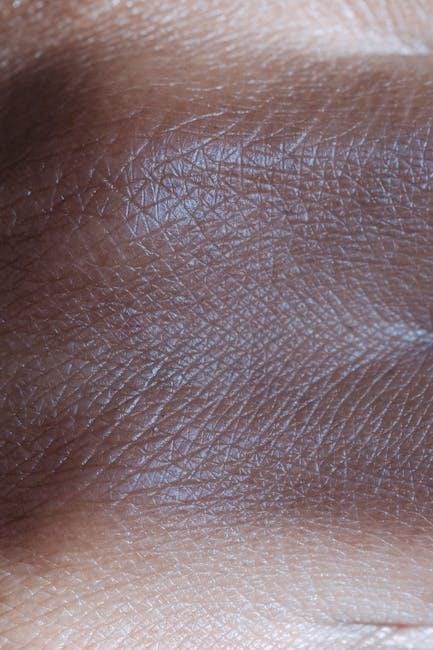This laboratory manual provides a comprehensive guide for healthcare students, offering essential experiments and practical exercises to explore human anatomy and physiology effectively.
1.1 Overview of the Lab Manual’s Purpose and Structure
This manual is designed for healthcare students, providing hands-on experiments to explore human anatomy and physiology. Organized into clear sections, it covers essential body systems through practical exercises, activities, and assessments, ensuring a structured approach to learning complex biological concepts effectively.
1.2 Importance of Hands-On Learning in Anatomy and Physiology
Hands-on learning is crucial for mastering anatomy and physiology, as it bridges theoretical knowledge with practical application. Lab experiments and activities allow students to explore complex biological structures and processes, enhancing understanding and retention. This experiential approach prepares healthcare students for real-world scenarios, making it an essential component of their education.
Essential Anatomical Terms and Concepts
This section introduces foundational anatomical terminology and concepts, such as directional terms and body planes, essential for understanding human structure and facilitating further detailed study.
2.1 Understanding Anatomical Position and Planes
Anatomical position refers to standing upright with arms at sides and palms facing forward. The body is divided into three planes: sagittal, frontal, and transverse. These planes help in describing the location and orientation of body structures, ensuring clear communication among healthcare professionals and students during dissection and clinical examinations. Accurate terminology is crucial for precise descriptions and effective learning.
2.2 Key Terminology for Body Systems and Functions
Mastering key terms is vital for understanding body systems. Terms like “sagittal,” “frontal,” and “transverse” describe planes, while “proximal” and “distal” locate structures. Understanding prefixes, suffixes, and roots aids in deciphering medical terminology. Familiarity with terms like “homeostasis” and “nervous system” enhances comprehension of physiological processes, enabling effective communication and application in laboratory and clinical settings.
Fundamental Physiological Principles
Understanding homeostasis, negative feedback, and the nervous system’s regulatory roles is crucial for grasping physiological processes, enabling students to apply these concepts in laboratory experiments effectively.
3.1 Homeostasis and Its Role in Bodily Functions
Homeostasis is the body’s vital mechanism for maintaining internal stability, regulating factors like temperature, pH, and blood glucose levels. This balance ensures proper cellular function and overall health. Through feedback loops, the body adjusts to external changes, preventing deviations that could disrupt normal physiological processes. Understanding homeostasis is key to appreciating how the body sustains life and responds to stressors effectively.
3.2 The Nervous System’s Control Over Physiological Processes
The nervous system orchestrates bodily functions through neural signaling, enabling communication between cells, tissues, and organs. It regulates involuntary actions like heart rate and digestion, while also facilitating voluntary movements and cognitive processes. By integrating sensory inputs and directing responses, the nervous system ensures adaptive and coordinated physiological activities, maintaining homeostasis and enabling the body to react to internal and external stimuli efficiently.
Lab Safety and Equipment
Adhering to safety protocols and using essential tools properly ensures a secure and effective learning environment for anatomy and physiology lab experiments and investigations.
4.1 Safety Protocols in the Anatomy & Physiology Lab
Essential safety measures include proper handling of biological specimens, wearing protective gear, and following chemical safety guidelines. Disposal of waste and adherence to emergency procedures are critical. Students must maintain a clean workspace and avoid hazardous practices under instructor supervision to ensure a safe and effective learning environment.
4.2 Essential Tools and Equipment for Lab Experiments
Essential tools include microscopes for tissue examination, dissecting kits with scalpels and forceps, and anatomical models for visualizing body systems. Measurement tools like calipers and thermometers are used for physiological experiments. Safety equipment such as gloves, goggles, and lab coats is mandatory. Proper use and maintenance of equipment ensure effective learning and safety in the lab environment.
The Skeletal System
The skeletal system comprises bones, joints, and ligaments, providing structural support, protection, and movement. It also produces blood cells and stores calcium, essential for bodily functions.
5.1 Identifying Bones and Their Functions
Bones are classified into long, short, flat, irregular, and sesamoid types, each serving unique roles. They provide structural support, protect internal organs, facilitate movement, and house bone marrow for blood cell production. Understanding their anatomy and functions is crucial for comprehending the skeletal system’s role in overall bodily mechanics and health.
5.2 Joints and Their Classification
Joints, or articulations, are points where bones connect. They are classified into three main types: synarthroses (immovable), amphiarthroses (slightly movable), and diarthroses (freely movable). Synarthroses, like skull sutures, allow no movement. Amphiarthroses, such as intervertebral discs, permit limited motion. Diarthroses, including knee and shoulder joints, enable wide-ranging movement, facilitating activities like walking and throwing, essential for daily mobility and function.
The Muscular System
The muscular system consists of skeletal, smooth, and cardiac muscles, each with unique roles in movement, stability, and internal processes. Studying muscle structure and function enhances understanding of human mobility and its application in healthcare.
6.1 Types of Muscles and Their Roles
The three types of muscles—skeletal, smooth, and cardiac—each serve distinct functions. Skeletal muscles enable voluntary movement, smooth muscles handle involuntary contractions, and cardiac muscles maintain heartbeats. Understanding their unique roles is crucial for grasping human physiology and diagnosing muscle-related disorders, making them a cornerstone of anatomy and physiology studies.
6.2 Muscle Structure and Movement Mechanics
Muscles are composed of muscle fibers encased in connective tissue. The sarcolemma, sarcoplasm, and myofibrils within fibers facilitate contraction. The sliding filament theory explains how actin and myosin filaments interact to produce movement. This structure enables muscles to generate force, essential for locomotion, maintaining posture, and regulating body functions, making it a vital component of the musculoskeletal system.

The Nervous System
The nervous system is a complex network controlling voluntary and involuntary functions. It comprises the central and peripheral systems, with neurons as functional units. Communication occurs through synapses, enabling control of movement, sensory processing, and reflex responses, essential for survival and interaction with the environment.
7.1 Structure and Function of Neurons
Neurons are specialized cells with dendrites, a cell body, and an axon. They transmit signals through electrical impulses and chemical neurotransmitters. Dendrites receive stimuli, while the axon conducts signals to synapses, enabling communication with other neurons or target cells. This structure facilitates sensory input, processing, and motor responses, forming the basis of nervous system functionality and control over bodily functions.
7.2 Reflexes and the Somatic Nervous System
Reflexes are automatic responses to stimuli, involving sensory neurons, motor neurons, and the CNS. The somatic nervous system controls voluntary actions, while reflexes are involuntary. Both rely on neural pathways to transmit signals, enabling rapid responses like withdrawing a hand from heat. Understanding these mechanisms is crucial for exploring nervous system functions in laboratory settings.
The Circulatory System
The circulatory system transports oxygen, nutrients, and hormones via blood, ensuring cellular survival. It comprises the heart, blood vessels, and blood, functioning as a vital network for maintaining life.
8.1 Blood Composition and Its Functions
Blood consists of plasma, red blood cells, white blood cells, and platelets. It transports oxygen, nutrients, hormones, and waste products, while also aiding in immune responses and clotting. Its composition is vital for maintaining homeostasis and overall bodily functions, ensuring proper cellular nourishment and protection against infections and injuries.
8.2 Heart Structure and Blood Circulation
The heart, a muscular organ, pumps blood through its chambers: the atria and ventricles. It ensures deoxygenated blood reaches the lungs and oxygenated blood circulates to tissues. Valves prevent backflow, maintaining efficient circulation. This process sustains cellular oxygenation and nutrient delivery, crucial for overall bodily function and metabolism.

Histology and Cellular Structure
Histology examines tissue composition under microscopes, revealing cellular organization and function. Understanding tissue types and cellular structures is vital for grasping anatomical and physiological processes.
9.1 Examining Tissues Under a Microscope
Examining tissues under a microscope involves preparing sections, staining, and observing cellular structures. This process helps identify tissue types, such as epithelial, connective, muscle, and nervous tissue, and their arrangements. Understanding tissue morphology aids in recognizing normal and abnormal cellular patterns, essential for diagnosing diseases. This skill enhances observation and analytical abilities in anatomy and physiology studies.
9.2 Cellular Level Functions in Anatomy and Physiology
Cellular functions are vital for maintaining life, involving processes like metabolism, signaling, and reproduction. These functions are essential for understanding how cells contribute to overall anatomical and physiological processes. Laboratory exercises, such as histological preparations and microscopic examinations, provide hands-on opportunities for students to explore cellular structures and their roles in human biology.
The Digestive System
The digestive system processes food into nutrients, involving organs like the mouth, esophagus, stomach, small intestine, and large intestine, performing ingestion, digestion, absorption, and elimination.
10.1 Organs and Processes of Digestion
The digestive system comprises the mouth, esophagus, stomach, small intestine, and large intestine. These organs work together to break down food through mechanical and chemical processes, enabling nutrient absorption and waste elimination. Each organ plays a specific role, from ingestion and mechanical digestion in the mouth to absorption in the intestines, ensuring proper nutrient utilization by the body.
10;2 Nutrient Absorption and Utilization
Nutrient absorption primarily occurs in the small intestine, where specialized villi increase surface area for efficient uptake. Enzymatic digestion breaks down carbohydrates, proteins, and fats into simpler forms. Absorbed nutrients enter the bloodstream, transported to the liver for processing. Cells utilize these nutrients for energy production, growth, and repair, ensuring optimal bodily functions and maintaining overall health through proper metabolic processes.
The Respiratory System
The respiratory system facilitates gas exchange, enabling oxygen intake and carbon dioxide expulsion; Breathing mechanics involve inhalation and exhalation, essential for maintaining cellular respiration and overall vitality.
11.1 Mechanics of Breathing and Gas Exchange
Breathing involves the coordinated effort of the diaphragm and intercostal muscles, creating pressure changes for air to enter and exit the lungs. Gas exchange occurs in the alveoli, where oxygen diffuses into blood and carbon dioxide is removed, ensuring proper cellular respiration and maintaining acid-base balance. This process is vital for delivering oxygen to tissues and removing metabolic waste products efficiently.
11.2 Blood Oxygenation and Carbon Dioxide Removal
Blood oxygenation occurs in the alveoli, where oxygen binds to hemoglobin in red blood cells, ensuring oxygen delivery to tissues. Conversely, carbon dioxide, a metabolic byproduct, is transported back to the lungs via the bloodstream and exhaled. This efficient exchange maintains cellular respiration and acid-base balance, highlighting the critical role of the respiratory system in sustaining life and overall bodily functions.

The Urinary System
The urinary system, comprising kidneys, ureters, bladder, and urethra, regulates fluid balance, removes waste, and maintains electrolyte and pH homeostasis, ensuring overall bodily health and function.
12.1 Kidney Function and Urine Formation
Kidneys filter blood, removing waste and excess substances to produce urine. This process involves glomerular filtration, tubular reabsorption, and secretion, regulated by hormones, ensuring proper electrolyte balance and fluid levels in the body. Understanding these mechanisms is crucial for comprehending renal physiology and its role in maintaining homeostasis.
12.2 Regulation of Fluid Balance and pH
The kidneys regulate fluid balance by adjusting water reabsorption and electrolyte levels. They maintain pH homeostasis through buffering systems and excreting excess hydrogen ions. Hormones like aldosterone and antidiuretic hormone further modulate these processes, ensuring optimal bodily functions and overall health.

Integration of Knowledge and Practical Application
Lab experiments connect theoretical concepts to real-world scenarios, enhancing understanding and preparing students for practical assessments in anatomy and physiology.
13.1 Relating Lab Experiments to Real-World Scenarios
Lab experiments bridge theory and practice by simulating real medical scenarios, such as dissections and physiological measurements. These exercises enable students to apply anatomical and physiological knowledge to diagnose and understand diseases, injuries, and treatments. This practical approach helps future healthcare professionals develop critical thinking and problem-solving skills essential for patient care and medical research.
13.2 Preparing for Lab Exams and Practical Assessments
Thorough preparation for lab exams involves reviewing lecture notes, lab manuals, and practice questions. Focus on understanding key concepts, such as anatomical structures and physiological processes. Regular revision and active participation in lab sessions enhance practical skills, ensuring readiness for assessments. Utilize online resources and study groups to reinforce learning and achieve success in practical evaluations.
